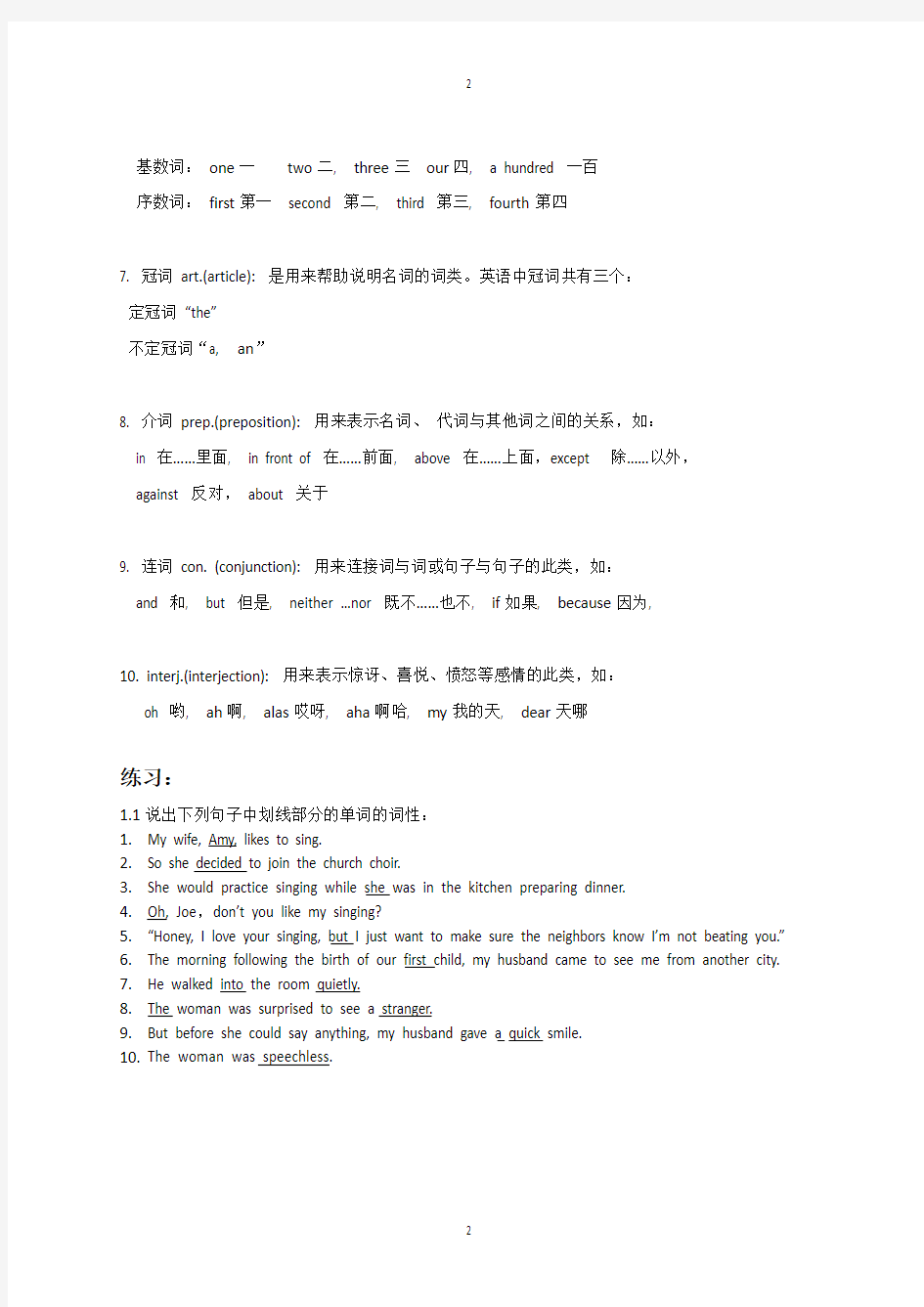

简明英语语法
第一单元词性(Parts of Speech)
英语中的词是构成句子的基本单位,根据其意义或在句中的作用,分为10种类型:
(1)名词(2)代词(3)动词(4)形容词(5)副词
(6)数词(7)冠词(8)介词(9)连词(10)感叹词
其含义简述如下:
1. 名词n. (noun): 表示人、物的名称的词类,如:
Tom 汤姆, table 桌子, river 河流, happiness 幸福, China中国
2. 代词pron. (pronoun): 代替名词的词类,如:
I我, you你, this 这个, those那些, who谁, what 什么, some一些
3. 动词v. (verb): 表示动作的词类,如:
walk 走, speak说, jump跳, feel 感到, prove 证实
4.形容词adj. (adjective): 用来修饰名词,表示人或事物的特征, 如:
big —a big table 大桌子,small —a small river 小河,
old —an old man 老人,clever —a clever boy 聪敏的男孩
5. 副词adv. (adverb): 用来修饰动词、形容词、副词的此类,如:
quickly快—She walked quickly away.(修饰动词walk)她迅速走开了。
extremely 极度地—The meeting is extremely important.(修饰形容词important) 这次会议极其重要。
6.数词num. (numeral): 是表示数量和序数的词。分为基数词和序数词,如:
基数词:one一two二, three三our四, a hundred 一百
序数词:first第一second 第二, third 第三, fourth第四
7. 冠词art.(article): 是用来帮助说明名词的词类。英语中冠词共有三个:
定冠词“the”
不定冠词“a, an”
8. 介词prep.(preposition): 用来表示名词、代词与其他词之间的关系,如:
in 在……里面, in front of 在……前面, above 在……上面,except 除……以外,
against 反对,about 关于
9. 连词con. (conjunction): 用来连接词与词或句子与句子的此类,如:
and 和, but 但是, neither …nor 既不……也不, if如果, because因为,
10. interj.(interjection): 用来表示惊讶、喜悦、愤怒等感情的此类,如:
oh 哟, ah啊, alas哎呀, aha啊哈, my我的天, dear天哪
练习:
1.1说出下列句子中划线部分的单词的词性:
1.My wife, Amy, likes to sing.
2.So she decided to join the church choir.
3.She would practice singing while she was in the kitchen preparing dinner.
4.Oh, Joe,don’t you like my singing?
5.“Honey, I love your singing, but I just want to make sure the neighbors know I’m not beating you.”
6.The morning following the birth of our first child, my husband came to see me from another city.
7.He walked into the room quietly.
8.The woman was surprised to see a stranger.
9.But before she could say anything, my husband gave a quick smile.
10.The woman was speechless.
练习答案
1.1 说出下列句子中划线部分的单词的词性
1.名词
2. 动词
3. 代词
4. 感叹词
5. 连词
6. 序数词
7. into 介词, quietly副词
8. the 冠词,stranger名词9. a 冠词,quick形容词10. 形容词
第二单元句子成分(Members of Sentences)
英语句子由此或词组构成。每一个词或词组在句中具有各自的功能。我们把词或词组的功能称为“句子成分”。共有六种成分:
(1)主语(2)谓语(3)宾语(4)表语(5)定语(6)状语
其含义简述如下:
1、主语(Subject):
主语是句子中需要加以说明和描述的对象,如:
●The plane has just taken off. 飞机刚起飞。
主语
●Pride goes before a fall. 骄必败。
主语
●May I ask you a question? 我可以问个问题吗?
主语
主语一般有名词或代词来充当。
2、谓语(Predicate):
谓语表示主语的动作,如:
●I played basketball yesterday afternoon. 昨天下午我打了篮球。
谓语
●Everyone enjoy s the challenge of quizzes. 人人都喜欢猜谜语。
谓语
谓语一般由动词来充当。
3、宾语(object):
宾语是表示动作的对象或承受者,如:
●Peter bought a new dictionary. 彼德买了一本新词典。
宾语
●I shall answer your question after class. 我课后再回答你的问题。
宾语
宾语通常由名词或代词来充当。
4、表语(Complement)
表语用来说明主语的身份、性质、状态和特征,如:
●He is a poet. 他是一位诗人。
表语
●The soup is delicious. 这汤味道真好。
表语
●My luggage is in the car. 我的行李在车里。
表语
表语一般有名词或形容词来充当。
5、定语(attributive)
定语用来修饰名词或代词,如:
●The family are fond of classical music. 这家人喜欢古典音乐。
定语
● A happy person makes a better parent. 性格开朗的人更能成为一名好的家长。
定语
定语主要由形容词来充当。
6、状语(adverbial)
状语用来说明事件发生的地点、时间、条件、原因、结果、目的、让步、程度、比较和方式等。例如:
(1)动词:
●He speaks French fluently. 她法语说得很流利。
状语
●The match was put off because of rain. 比赛因天雨而推迟。
状语
(2)形容词:I’m very happy to see you all. 我很高兴见到大家。
状语
(3 ) 副词:The traffic is moving pretty slowly 交通很堵。
状语
(4)整个句子:Luckily, he wasn’t injured. 幸运得很,她没有受伤。
状语
状语主要由副词或短语来充当。
练习
2.1 指出下列句子中的划线部分做什么句子成分:
1.Experience is the best teacher.
2.I encourage you all work hard, help each other and build a better future.
3.Finally, I’d like to summarize the main points.
4.Was the bridge built last year?
5.Did you buy a gift for your father on Father’s Day ?
6. A company isn’t just a name and a building.
7.Probably, we’ll drop in on professor Jackson.
8.He called a moment ago.
9.The economy has made a dramatic turn around in Asia.
练习答案
2.1 指出下列句子中的划线部分做什么句子成分:
1. Experience is the best teacher. 主语
2.I encourage you all work hard, help each other and build a better future. 谓语
3.Finally, I’d like to summarize the main points. 定语
4.Was the bridge built last year? 谓语
5.Did you buy a gift for your father on Father’s Day ? 宾语
6. A company isn’t just a name and a building. 表语
7.Probably, we’ll drop in on professor Jackson. 状语(修饰整句)
8.He called a moment ago. 状语(表示时间)
9.The economy has made a dramatic turn around in Asia. 状语(表示地点)
第三单元语序(Word order)
每一种语言都有自己的遣词造句的规则。例如,我们能理解这样的中文句子:“我们都喜欢打蓝球”
但是,我们不能理解以下的句子:
“都打喜欢篮球我们”
“喜欢篮球打我们都”
同样,英语也有它自己的遣词造句的规则,英语句子的语序共有以下7种类型:
1.主语+ 谓语
The girl cried. 女孩哭了。
The students are dancing 学生们在跳舞。
2.主语+ 谓语+ 宾语
We like music. 我们喜欢音乐。
He studies economy. 他研究经济。.
3. 主语+ 谓语(be动词) + 表语
Her father is a doctor. 她的父亲是一名医生。
The book is interesting. 这本书很有趣。
My favorite holiday is thanksgiving. 我喜爱的节日是感恩节。
4. 主语+ 谓语+ 状语
They work hard. 他们努力工作。
5. 主语+ 谓语+ 宾语+ 状语
She teaches English in an evening school. 她在一所夜校教英语。
6. 主语+ 谓语+ 间接宾语+ 直接宾语
He gave Mary a rose. 他给玛丽一朵玫瑰花。
Mom made me a skirt. 妈妈为我做了一条裙子。
注意:
间接宾语一般指人,直接宾语一般指事物。
7.主语+ 谓语+宾语+ 宾语补语
Everybody believed him honest. 人人都相信他是诚实的。
The director told Angela to sit down. 导演让安吉拉坐下。
注意:
句中“honest” 是用来补充说明宾语”him”的,称为“宾语补语”。宾语补语可以由形容词、名词、分词短语、不定式、介词短语等来充当。
英语句子纵然千变万化,但是,万变不离以上7种基本句型结构。
练习
3.1分析下列句子的语序(用“主语+ 谓语+ ......”表示):
1. Beethoven was a greatest musicians.
2. We went ashore after swimming for an hour.
3. Fast food restaurants are popular.
4. I don’t understand the sentence.
5.Cola companies keep their exact recipes a secret.
6.The customer puts a coin into the machine.
7.His plan has changed.
8.She told me all about it.
练习答案
3.1分析下列句子的语序
1. Beethoven was a greatest musicians. 主语+ 谓语(be动词) + 表语
2.We went ashore after swimming for an hour. 主语+ 谓语+ 状语
3, Fast food restaurants are popular. 主语+ 谓语(be动词) + 表语
4.I don’t understand the sentence. 主语+ 谓语+ 宾语
5.Cola companies keep their exact recipes a secret. 主语+ 谓语+ 宾语+ 宾语补语
6.The customer puts a coin into the machine, 主语+ 谓语+ 状语.
7.His plan has changed. 主语+ 谓语
8.She told me all about it. 主语+ 谓语+ 间接宾语+ 直接宾语
语序(补充)
在上一章中“句子的基本类型”中描述了主语、谓语、表语和宾语在句子中的位置。在一般情况下英语的句子基本遵循这4种核心语序:
1.主语+ 谓语(The students are swimming.)
2.主语+ 谓语+ 宾语(The student are listening to music.)
3.主语+ 联系动词+ 表语(They are students.) (The students are energetic.)
4.主语+ 谓语+ 间接宾语+ 直接宾语(The teacher gave students some books.)
在这一章节中我们将着重了解定语和状语在句子中的位置。
1.定语的位置
我们知道定语主要功能是修饰名词。在一般情况下,定语置于它所修饰的名词之前,例如:
●We can find useful information online. 我们可在网上找到有用的信息。
定语(修饰名词information)
●Ann was very happy when she passed her exam.
定语(修饰名词exam)
安妮通过了考试,非常高兴。
以下情况,定语必须置于它所修饰词之后:
(1)当定语是由短语构成时:
●Henry was a boy curious about anything.亨利是一位对于任何事都很好奇的孩子。
定语(修饰boy)
●This is a book easy to read. 这是一本容易读的书。
定语(修饰book)
(2)当定语修饰some, any, no 以及-thing, -one, -body合成的不定代词:
●There is nothing dangerous here. 这儿一点都不危险。
定语(修饰nothing)
●Don’t do anything stupid. 别做蠢事。
定语(修饰anything)
2.状语的位置
一般情况下,状语一般位于句末,例如:
●She speaks English perfectly. 她英语说得很好。
状语
●Tom drove carefully along the narrow street. 汤姆狭窄的路上小心地驾车。
状语状语
●She smiled at me in a friendly way. 她友好地对我微笑。
状语
为了强调状语,也可以把状语置于句首,例如:
●Suddenly, the baby burst into cry. 突然,小孩大哭起来。
状语
●In 1921,Einstein won the Nobel Price for Physics.
状语
1921年爱因斯坦获诺贝尔物理奖。